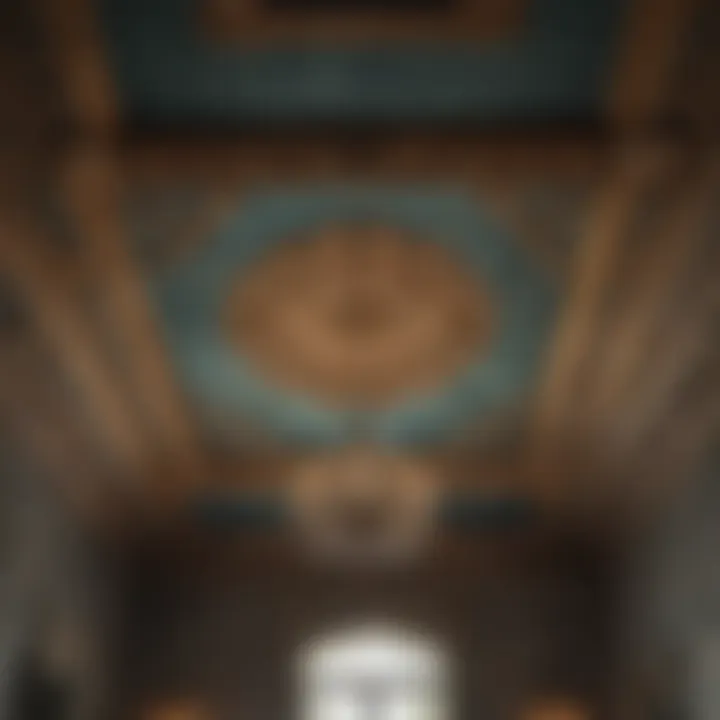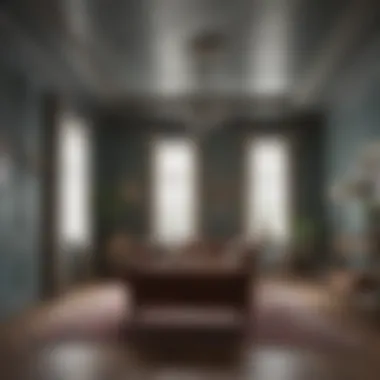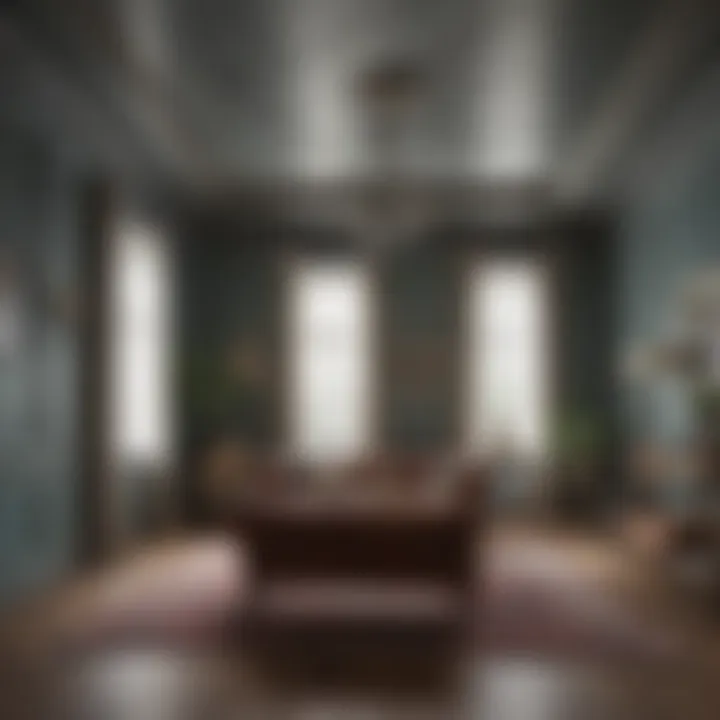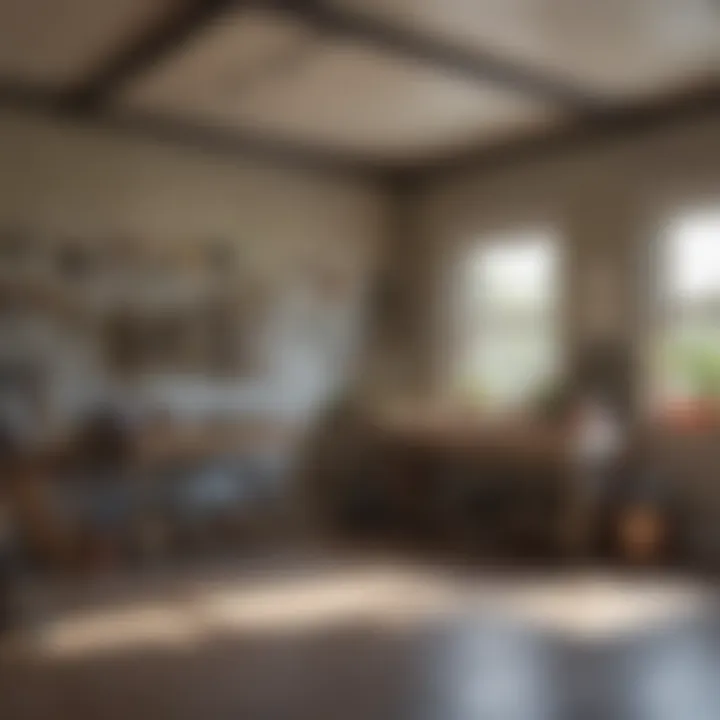Choosing Between Painting Ceilings and Walls


Intro
Determining whether to paint the ceiling or walls first during a renovation can feel like facing a double-edged sword. The choice carries practical implications that can affect the overall look and feel of a room. Many homeowners and design enthusiasts find themselves wrestling with this dilemma, often seeking clarity on the best approach.
As we delve into this topic, consider how each choice influences your painting experience, impacts the finish, and shapes the entire ambiance of the space. Painting isn’t merely a chore; it’s a transformative process that can breathe new life into your home. Hence, grasping the nuances of ceilings vs. walls will empower you no matter where you are on your decorating journey.
Interior Design Tips
When it comes to the world of interior design, the way you approach paint projects can set the tone for entire spaces. Here are some tips to illuminate your path:
- Assess Room Height: In rooms with low ceilings, painting the ceiling a lighter color can create an illusion of height. On the flip side, if you’re aiming to create a cozy effect in a spacious area, a darker ceiling might do the trick.
- Lighting Factors: Consider how natural light interacts with both the walls and ceilings. A light color on the ceiling may reflect light well, while more saturated colors can provide warmth and intimacy.
- Coordination with Decor Elements: Make sure your paint choices work harmoniously with existing furniture, window treatments, and accessories. A well-thought-out color scheme can elevate the overall aesthetic.
Color Schemes and Combinations
Color is a critical player in the decision-making dance. Here, we’ll explore how colors affect your space:
Choosing the right combinations can stir emotions and influence perceptions.
- Complementary Colors: Using colors that oppose each other on the color wheel can make for vibrant contrasts, perfect for enhancing dynamic spaces like living rooms or playrooms.
- Monochromatic Schemes: This often involves variations of one hue—ideal for tranquil settings such as bedrooms. It helps achieve soothing vibes while maintaining interest through different shades.
A Focus on Practicality
It also pays to consider the practicality of your choices. Start with this guideline:
- Painting the Ceiling First: If you decide to paint the ceiling first, you can easily roll paint on without worry. Any splatters on the walls can be covered up later.
- Starting with Walls: Conversely, if your walls need extensive preparation or lots of coats, it may be better to tackle them first.
There’s no steadfast rule but assessing your specific project may lead to a clearer path.
The End
Prelude to Painting Basics
When it comes to giving a room a fresh look, painting is often the go-to method for many homeowners and interior design aficionados. However, deciding whether to tackle the ceiling or the walls first can spark a bit of debate. Understanding the painting process is fundamental in this context. The way paint is applied can dramatically affect the outcome of your project, influencing everything from workflow efficiency to the final aesthetic. Not only does a proper understanding streamline the work, but it also minimizes the potential for mishaps.
Moreover, using the right tools and materials can make all the difference. By knowing what to expect—and what to avoid—you can elevate your project from mediocre to magnificent. This article will delve into these essentials, guiding you through a labyrinth of options, methods, and outcomes.
Understanding the Painting Process
Grasping the painting process is key. Initially, it may seem like a simple task; however, there are several layers—literally and metaphorically. Planning your approach requires a thorough consideration of both the surface's condition and the type of finish desired. For instance, older homes may have imperfections that need attention. Ignoring these can lead to a lumpy finish, making the paint job look less than stellar.
It's also crucial to remember that creating an even and pleasing surface isn’t simply about slapping color on. Priming surfaces, especially after repairs, is often necessary to ensure proper adhesion. This foundational step is where many novice painters miss the mark.
Tools and Materials Overview
Preparing for a painting project is akin to gearing up for a long trek. The right tools can make the journey less arduous. Here's a handy breakdown of what you'll need:
- Paint Brushes and Rollers: For precision, make sure to have different sizes. A small brush is great for corners, while a roller can efficiently cover larger surfaces.
- Drop Cloths: Protect your floors and furniture. After all, accidents happen, and it’s easier to clean up before a spill happens.
- Painter’s Tape: It ensures clean lines, preventing paint from seeping onto unwanted areas.
- Ladders or Scaffolding: Depending on your ceiling height, these might be essential for reaching those tricky spots safely.
- Paint Trays and Liners: Keep things organized and clean while you work.
- Roller Extensions: If your ceiling has a height that resembles the Sistine Chapel, these will save your back.
Arming yourself with the right knowledge and equipment will set you on the path to a successful painting experience. Don't underestimate the significance of preparation; it can be the difference between a half-baked job and a polished masterpiece.


Ceiling Painting: The First Approach
When it comes to beautifying a room, the ceiling often seems to be an overlooked canvas. Many homeowners might think it’s just a surface to provide a roof over their heads. However, understanding the importance of ceiling painting can elevate your room's aesthetic, creating a harmonious and spacious atmosphere. Choosing to paint the ceiling first sets the stage for a cohesive design that is more than skin-deep. This section delves into the reasons why addressing the ceiling initially is worth considering, along with its benefits and the challenges that may crop up.
Benefits of Painting the Ceiling First
Opting to paint the ceiling before the walls carries several advantages. First off, when you take this approach, any drips or spills that occur from painting the overhead surface are less likely to spoil your wall finish. It's a smart strategy that keeps your hard work intact.
- Enhanced Overall Finish: A freshly painted ceiling can make a room feel more open and airy. Light-colored ceilings reflect light, giving the illusion of more space, while darker shades can create a cozy feel.
- Time Efficiency: If you paint the ceilings first, you can follow up with the walls and touch-ups without worrying about ceiling drips ruining your walls.
- Fewer Touch-Ups: Any accidental splatters on the walls can easily be covered up during wall painting, minimizing unnecessary work later.
Making the ceiling your primary focus can clearly transform your perception of a room and it's practical to avoid any extra effort needed for corrections down the line.
Challenges Encountered with Ceilings
While painting ceiling first comes with benefits, it isn't without its own set of hurdles. Understanding these challenges will help prepare you for a smoother painting process.
- Height Hazards: If your ceilings are high, you might find reaching certain areas can be a neck-wrenching ordeal. A good ladder is essential, but safety should always come first.
- Overhead Work: Painting overhead can be a strain on the arms and back, making the process far from enjoyable. Don’t underestimate the physical toll it takes to keep your arm raised for lengthy periods.
- Visibility Challenges: Spotting imperfections or areas that need more attention can be difficult on a ceiling. Without adequate lighting, what seems like smooth sailing might turn out to be a choppy sea of touch-ups.
These drawbacks are worth considering, but with the right preparation and tools, they can be effectively managed.
Recommended Techniques for Ceiling Application
Mastering the art of ceiling painting requires some specialized techniques to achieve a flawless finish. While it's easy to underestimate the skill needed, here are some tips to keep in mind:
- Use the Right Ladder: A sturdy ladder that allows you to reach the ceiling without straining is vital.
- Applying Primer: If you're dealing with stains or transitions between colors, a primer coat ensures uniform adhesion and finish.
- Roller for Large Areas: Using a roller attached to an extension pole can save both time and effort. It covers more area and helps prevent drips that might occur with a brush.
- Cut-In with a Brush: While the roller handles the majority, a small brush is essential for corners and edges, providing a clean and sharp line.
"In the world of interior painting, the ceiling serves as the unsung hero, underscoring the beauty of the walls."
Maintaining an even and thorough application will ensure that your ceiling becomes a source of admiration rather than an overlooked afterthought in your home’s overall design.
Wall Painting: The Alternative Method
When it comes to home renovations, the choice to prioritize wall painting is not just a matter of aesthetics. It's about understanding the practical implications that stem from this decision. Walls often serve as the backdrop for our lives; they frame our memories and set the tone for the ambiance of a room. In this section, we'll dig into the aspects of wall painting as an alternative method, exploring its benefits, potential downsides, and effective techniques for a satisfying finish.
Advantages of Starting with Walls
Starting with wall painting can have multiple advantages. This method can save time and hassle, allowing for a smoother overall process.
- Less Messy: Walls can attract splatters and drips. By painting them first, you can avoid the inevitable cleanup that comes when ceilings are painted after walls.
- Easier Touch-ups: If your walls require touch-ups or additional coats, it's easier to do so without having to worry about protecting your ceiling paint.
- No Overlaps: It's simpler to cover overlapping edges where the wall meets the ceiling when you take care of the walls first. This can create a cleaner line and a more polished finish.
- Color Effects: If you paint the walls first, they can influence how the ceiling color appears in contrast. The interplay between the two can be remarkable, adding depth to your overall scheme.
Considerations Against Wall Painting First
While there are several compelling reasons to start with walls, there are also considerations to keep in mind. Often, these aspects hinge on the specific context of the space and the desired outcomes.
- Ceiling Repair: If your ceiling needs attention, such as patching or repainting, doing walls first could mean having to navigate around those repairs.
- Dripping Paint: Paint from the ceiling might drip onto your freshly painted walls, leading to unnecessary extra work.
- Color Coordination: Choosing to paint ceilings first allows room for better visual harmonization as the ceiling color can set the tone for each wall.
- Heightened Ambiance: The nature of painted ceilings, especially in darker shades, can create a cozy atmosphere that might be overlooked if wall colors are chosen first.
Effective Wall Painting Techniques
To maximize the impact of your wall painting efforts, employing effective techniques is key. Here are some best practices to consider:
- Preparation is Key: Always fill any holes or cracks on the walls before painting. Sanding down the surfaces can also elevate the finish quality.
- Quality Materials: Using high-quality paintbrushes and rollers will not only enhance application but also contribute to longevity. Brands like Sherwin-Williams or Behr often provide great durability in their products.
- Use Primer: Applying primer can prevent the wall color from looking patchy and can improve the vibrancy of the top coat.
- Technique Matters: Using the "W" technique when rolling can distribute paint more evenly. Start from the corner of the wall and work your way out for better coverage.
- Proper Ventilation: Make sure the area is well-ventilated to help the paint dry smoothly and quickly. This minimizes the wait time between coats, if additional layers are needed.


"A well-painted wall isn’t just about color; it’s about creating an experience within a room that speaks to who you are."
By understanding these aspects, homeowners and design enthusiasts can make a more informed decision on whether to tackle wall painting first. The balance of striking a visually appealing finish while ensuring efficient workflow is an art in itself, making this discussion crucial as you prepare for your next painting project.
Comparative Analysis: Ceiling vs. Wall First
When pondering the conundrum of whether to paint the ceiling or walls first, one must delve into several critical aspects that not only affect the aesthetic outcome but also the practicalities of the task at hand. This section compares the relative merits and drawbacks of each approach, helping homeowners and design aficionados to determine the best path forward in their painting endeavors.
Time Efficiency and Workflow
In painting, time management can be just as vital as the technique itself. Choosing whether to tackle the ceiling or walls first influences the efficiency of the overall project.
One could argue that painting the ceiling first is often more time-efficient. By starting up high, it allows for gravity to do its work—drips and splatters can fall to areas where floors or walls are yet to be painted, thus saving the hassle of touching up those surfaces later.
Conversely, beginning with the walls might feel more intuitive for some, especially those who envision a clean canvas prior to introducing color overhead. This method can lead to a prolonged workflow if the walls are painted first, as the ceiling will need to be painted afterward to prevent any overlapping issues, leading to unnecessary touch-ups and prolonged project duration.
Aesthetic Outcomes and Visual Impact
It's a common belief that the order of painting directly affects the visual outcome. Painting the ceiling first can help create a seamless look, especially in rooms with intricate crown moldings or other architectural details. If the walls are painted first, there's a risk of an uneven border where the two meet, which can betray the overall polish that one seeks in a well-painted room.
In terms of color choice, keep in mind that ceilings often reflect light differently than walls. A lighter shade on the ceiling can help make a room feel airy and spacious, while a darker or richly saturated wall can provide depth and character. To harmonize, one would benefit from considering how colors work together and the visual continuity depending on the painting order, ultimately shaping the room's atmosphere.
Cleaning and Touch-Up Considerations
After the last stroke of paint, cleaning up is the next hurdle. If one painted the ceiling first, any spills or markings that went south can be identified and rectified before they have a chance to dry on the walls. This means that, theoretically, touch-ups on the ceiling might be concluded before wall painting's conclusion, streamlining the overall cleanup process.
However, if you opt to paint the walls first, you might find yourself in an endless loop of touch-ups on the ceiling as you try to correct the flaws seen from the freshly painted walls. This can lead to frustration, and perhaps unintended drama in what should be a calm home improvement project.
Key Takeaway: Overall, the choice isn’t just a matter of what looks good; it’s about efficiency, aesthetics, and ultimately, how much elbow grease one is willing to invest in cleaning up the aftermath. Understanding these dynamics can lead to a more satisfying painting experience.
Special Situations: Factors That Influence Choice
In the realm of painting, deciding whether to tackle the ceiling or walls first can be a head-scratcher, especially when a few unique situations arise. This section delves into factors that can sway your decision—after all, the specifics of your environment might tilt the scale one way or the other. Whether you're working with a cozy den or a sprawling living room, understanding these nuances can transform your painting project from a chore into a tailored masterpiece.
Room Types and Their Requirements
Every room has its own character, almost like a personality, and this can dictate which area to paint first. For instance, a small bathroom often has limited space, where getting paint on the walls could mean risking a drippy ceiling. On the flip side, a spacious living area might welcome a more free-flowing approach, allowing for either method.
Key Considerations for Different Room Types:
- Kitchens: Often, kitchens require more rugged treatments, making wall painting a priority before the ceiling. Kitchens can get messy quickly, and painting the walls first lets you avoid splatters when you eventually do the ceiling.
- Children’s Rooms: This is a playful space that may see more lively colors or patterns. Focusing on walls first can allow for a fun design experience that you wouldn't want to interfere with, should the ceiling paint inadvertently drop.
- Basements: Lower ceilings are a common feature in basements. If you paint the walls first in this instance, you might minimize the feeling of confinement, especially if you’re aiming for lighter colors.
Understanding these distinct requirements helps ensure your painting project not only looks good but functions effectively within the space.
Impacts of Lighting and Color Scheme
Lighting plays a critical role in how colors are perceived. The interaction between painted surfaces and natural or artificial light can shift the mood and appearance. If your room has large windows or open views, painting the ceiling first might magnify the impact of the sunlight streaming in. On the other hand, in dim or artificially lit spaces, stronger wall colors can help brighten the area without needing to first address the ceiling.
Here’s what to take note of regarding light and color:
- Natural Light Exposure: Consider how light moves through the space. Rooms with significant exposure to sunlight might benefit from a careful balance in painting—the walls can be brighter while the ceiling absorbs light through a softer hue.
- Color Contrast: A bold wall color can create an intriguing visual play when paired with a subtle ceiling hue. In such cases, starting with the walls allows one to gauge the ambiance before finishing off the top.


"A well-considered color scheme can make even the smallest of rooms feel airy or even cozy, depending on how you blend wall and ceiling tones."
Existing Damage and Surface Preparation
Every surface tells a story, and sometimes that story includes wear and tear. If either your ceiling or walls has damage—think cracks, stains, or old paint bubbling up—taking the time to prepare can influence your order of operations. If the walls are in poor shape, they might need patchwork or extensive cleaning, thereby necessitating that they be painted first to avoid harming freshly painted ceilings.
A few tips for dealing with surface issues include:
- Repair Before Paint: Always repair any damages before painting. If ceilings have water stains, this should first be treated to prevent bleed-through. Painting the wall initially might only set you up for failure if you've got to return to fix the ceiling afterward.
- Cleanliness is Key: Make sure surfaces are clean. A dusty wall or ceiling can lead to poorly adhering paint regardless of where you start.
Closure: Making an Informed Decision
Making a choice about whether to paint your ceiling or walls first can be more than simple preference; it's a decision that can affect the entire painting project’s outcome. In this article, we’ve traversed the paths of considerations that matter, from the aesthetic effects to the practical workflow in any given space. Each aspect discussed serves as a guide to navigate this choice effectively. The importance of making an informed decision comes from understanding these nuances, preserving not only the quality of your work but also enhancing the overall atmosphere of your home.
Summarizing Key Considerations
When looking back on our exploration, a few key factors deserve spotlight:
- Type of Room: Think about the function of each room. A kitchen might benefit from a different approach compared to a bedroom.
- Lighting: Natural and artificial light can dramatically alter how colors appear. Be mindful of these shifts.
- Existing Damage: Address any imperfections or repairs before diving into color changes; otherwise, you may be painting over problems.
- Personal Preferences: What feels right for you matters most. Trust your instincts about color schemes and room designs.
These elements aren’t just technical details. They encapsulate the essence of what makes your home reflective of you. Understanding each one allows you to make a powerful, informed choice about your painting project.
Final Thoughts on Personal Preferences
Ultimately, your tastes and the way you envision your space can guide your decision. Perhaps you've always loved the look of a high-contrast ceiling and wall. Or maybe your style leans towards harmony, favoring similar tones on both surfaces.
Personal preferences can even dictate how you feel in a room. For instance, a lighter ceiling can create an illusion of height, contributing to a more airy feel everywhere. Conversely, darker hues can cocoon a space, promoting a sense of warmth and intimacy. As such, it’s beneficial to tap into your values and desires when making your decision.
In the end, there’s no one-size-fits-all approach when it comes to painting choices. As trends shift, so do personal preferences; what's essential is that the decision feels right for you. For more resources and ideas on room design and enhancements, consider browsing Wikipedia, Britannica, or join conversations on Reddit and Facebook.
"A home should be a reflection of who you are, a testament to your unique style and concepts."
Whether you go ceiling-first or wall-first, may your painting adventure result in a beautiful and personal transformation.
Frequently Asked Questions
This segment of the article is integral for those navigating the often murky waters of home painting. With the myriad of decisions at hand, the Frequently Asked Questions section serves as a beacon of clarity, guiding homeowners and design enthusiasts alike through common concerns and curiosities. From color choices to time estimates, these questions not only enlighten readers but also save them from potential headaches down the road.
Being informed helps create a smoother painting experience, addressing uncertainties that could otherwise lead to missteps. Ultimately, this portion emphasizes practical elements relevant to varied situations which many may encounter.
Should paint my ceiling and walls different colors?
Choosing whether to paint ceilings and walls in the same color or to go for a contrast is no small matter. The aesthetic implications can be significant. Paint color affects the overall mood of a room, influencing both light and space perception. Here are some important points to consider:
- Room Size and Height: Lighter colors on the ceiling can make a low room feel higher, while darker shades can add a sense of intimacy. If you have a small space, a single light color might work wonders. Conversely, a high ceiling might seem colder with a pale hue, suggesting a darker ceiling to maintain warmth.
- Flow and Cohesion: In open spaces where one sees multiple rooms at once, coordinating colors can maintain harmony. If each room has its own scheme, think about how they relate to one another.
- Accent Features: Different colors can highlight architectural features. If a room has crown moldings or unique trim, a contrasting ceiling color could help emphasize these details.
- Personal Preference: Of course, individual taste plays a massive role. What feels comfortable for you? Do you love bold contrasts or a tranquil and seamless look? Trust your instincts.
Colors are subjective, and having a good grasp on how these choices affect personal spaces is crucial.
How long does it take to paint a ceiling compared to walls?
Time consideration is crucial for any DIY enthusiast weighing their options. Generally, painting a ceiling tends to take more time than wall painting due to a few factors:
- Preparation: Ceiling preparation ideally involves more work. You need ladders or scaffolding to reach higher areas. Nothing fancy here—safety first. Proper setup can be time-consuming but is necessary for a clean job.
- Drying Time: Paint on ceilings may take longer to dry. The angle in which you apply and the amount of coats required can vary significantly compared to walls. Normally, two coats are standard. Consider an extra day if working in a humid area, as drying gets sluggish.
- Technique and Detail: Different techniques, such as rolling with a brush, require more precision when working overhead, thus soaking up time. Walls can often be rolled quickly with less concern for drips or splatter.
The time commitment isn’t just about getting it done; it’s about ensuring quality results. Rushing can lead to more errors and later touch-ups, which can be a pain.
Proper planning and understanding your tools, colors, and methods will lead to a smoother painting process, whether it be ceilings or walls.







